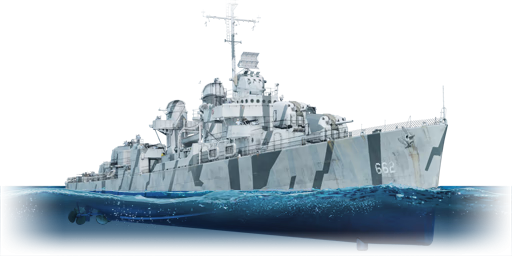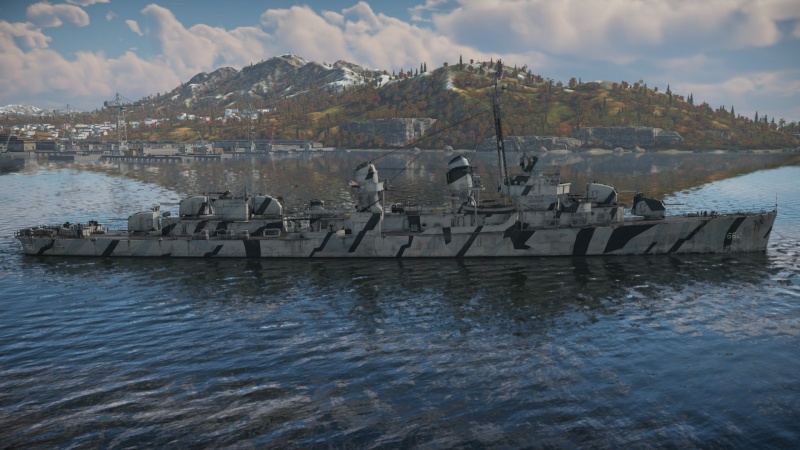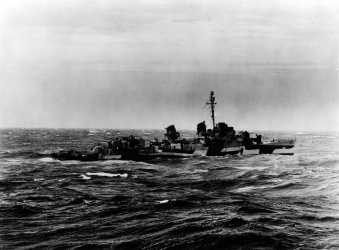USS Bennion
Contents
Description
The Fletcher-class, USS Bennion (DD-662), 1944 is a premium gift rank III American destroyer with a battle rating of 4.7 (AB/RB/SB). It was introduced in Update 1.79 "Project X" as an Xbox-exclusive vehicle purchasable on the Microsoft Store.
As a Fletcher-class destroyer, the USS Bennion resembles its sister ships USS Fletcher and USS Cowell in terms of performance characteristics. The most distinctive differences the USS Bennion has compared to its sisters is its unique dazzle camouflage, following the MS-32/13D design pattern. Compared to its closer relative, the Cowell, the Bennion possess an extra 5,000 rounds of 40 mm Bofors ammunition.
General info
Survivability and armour
As part of the Fletcher-class family, the USS Bennion's armour profile is not so different from its sisters, with armour plates covering the individual 127 mm gun turrets and primarily hull protection at the sides and roof.
Armour type:
- Antifragmentation armour
- Cast homogeneous armour
- Hardened armour
| Armour | Bow (Slope angle) | Sides | Stern | Deck |
|---|---|---|---|---|
| Hull | N/A | 13 mm (0-24°) | N/A | 13 mm (85-89°) |
| Armour | Front | Sides | Rear | Roof |
| Turrets | 3.2 mm Front 15 mm Gun mantlet |
3.2 mm | 3.2 mm | 3.2 mm |
Notes:
- The fire-control radar atop the bridge is covered with an antifragmentation armour with 19 mm thickness.
- Gun shields around the 20 mm Oerlikon autocannons are 12.7 mm thick.
Mobility
| Mobility Characteristics | |||
|---|---|---|---|
| Game Mode | Upgrade Status | Maximum Speed (km/h) | |
| Forward | Reverse | ||
| AB | |||
| Upgraded | 79 | 31 | |
| RB/SB | |||
| Upgraded | 65 | 25 | |
Modifications and economy
Armament
Primary armament
| 5 inch/38 Mk.12 (x5) | ||||||
|---|---|---|---|---|---|---|
| Turrets (Bow to stern) | ||||||
| Turret 1 | Turret 2 | Turret 3 | Turret 4 | Turret 5 | ||
| Vertical guidance | -15°/+85° | |||||
| Horizontal guidance | ±150° | ±143° | ±150° | |||
| Ammo capacity | 1,800 | |||||
Ammunition
| Penetration statistics | |||||||
|---|---|---|---|---|---|---|---|
| Ammunition | Type of warhead |
Penetration @ 0° Angle of Attack (mm) | |||||
| 1,000 m | 2,500 m | 5,000 m | 7,500 m | 10,000 m | 15,000 m | ||
| AAC Mk.34 | HE | 36 | 36 | 36 | 36 | 36 | 36 |
| Common Mk.32 | Common | 124 | 103 | 77 | 58 | 46 | 37 |
| SP Common Mk.46 | SP Common | 150 | 125 | 93 | 71 | 56 | 45 |
| AAVT Mk.31 | HE-VT | 36 | 36 | 36 | 36 | 36 | 36 |
| Shell details | |||||||||
|---|---|---|---|---|---|---|---|---|---|
| Ammunition | Type of warhead |
Velocity (m/s) |
Projectile mass (kg) |
Fuse delay (s) |
Fuse sensitivity (mm) |
Explosive mass (TNT equivalent) (g) |
Ricochet | ||
| 0% | 50% | 100% | |||||||
| AAC Mk.34 | HE | 792 | 25 | 0 | 0.1 | 3,220 | 79° | 80° | 81° |
| Common Mk.32 | Common | 792 | 24.49 | 0.01 | 6 | 1,150 | 47° | 60° | 65° |
| SP Common Mk.46 | SP Common | 792 | 25 | 0.01 | 6 | 906.5 | 48° | 63° | 71° |
| Proximity-fused shell details | |||||||||||
|---|---|---|---|---|---|---|---|---|---|---|---|
| Ammunition | Type of warhead |
Velocity (m/s) |
Projectile mass (kg) |
Fuse delay (m) |
Fuse sensitivity (mm) |
Arming distance (m) |
Trigger radius (m) |
Explosive mass (TNT equivalent) (g) |
Ricochet | ||
| 0% | 50% | 100% | |||||||||
| AAVT Mk.31 | HE-VT | 792 | 25 | 0 | 0.1 | 457 | 23 | 3,220 | 79° | 80° | 81° |
Secondary armament
| 40 mm Bofors L/60 Mark 1 (x10) | ||||||
|---|---|---|---|---|---|---|
| Turrets (Bow to stern) | ||||||
| Front port turret (x2) | Front starboard turret (x2) | Middle port turret (x2) | Middle starboard turret (x2) | Rear turret (x2) | ||
| Vertical guidance | -15°/+88° | -10°/+88° | -15°/+88° | |||
| Horizontal guidance | -150°/+90° | -90°/+150° | -180°/+20° | -20°/+180° | ±180° | |
| Ammo capacity | 25,000 | |||||
Ammunition
- Universal: AP-T · HEFI-T
- 40 mm HE clips: HEFI-T · HEFI-T · HEFI-T · AP-T
- 40 mm AP clips: AP-T · AP-T · AP-T · HEFI-T
| Penetration statistics | |||||||
|---|---|---|---|---|---|---|---|
| Ammunition | Type of warhead |
Penetration @ 0° Angle of Attack (mm) | |||||
| 10 m | 100 m | 500 m | 1,000 m | 1,500 m | 2,000 m | ||
| 40 mm HEFI-T | HEFI-T | 3 | 3 | 3 | 3 | 3 | 3 |
| 40 mm AP-T | AP-T | 81 | 78 | 68 | 58 | 49 | 41 |
| Shell details | |||||||||
|---|---|---|---|---|---|---|---|---|---|
| Ammunition | Type of warhead |
Velocity (m/s) |
Projectile mass (kg) |
Fuse delay (m) |
Fuse sensitivity (mm) |
Explosive mass (TNT equivalent) (g) |
Ricochet | ||
| 0% | 50% | 100% | |||||||
| 40 mm HEFI-T | HEFI-T | 874 | 0.9 | 0 | 0.1 | 67.13 | 79° | 80° | 81° |
| 40 mm AP-T | AP-T | 874 | 0.89 | N/A | N/A | N/A | 47° | 60° | 65° |
Anti-aircraft armament
| 20 mm Oerlikon Mk.II (x7) | |||||||
|---|---|---|---|---|---|---|---|
| Turrets (Bow to stern) | |||||||
| Front port turret | Middle port turret | Front starboard turret | Middle starboard turret | Rear port turret | Rear starboard turret | Rear stern turret | |
| Vertical guidance | -80°/+65° | ±100° | -65°/+80° | ±100° | ±180° | ||
| Horizontal guidance | -4°/+50° | ||||||
| Ammo capacity | 16,800 | ||||||
Additional armament
| 533 mm steam turbined Mk.15 torpedo (x10) | ||||||||
|---|---|---|---|---|---|---|---|---|
| Mode | Mass (kg) | Maximum speed in water (km/h) |
Travel distance (km) | Depth stroke (m) | Arming distance (m) |
Explosive type | Explosive mass (kg) | |
| Stock | 1,559 | 83 | 5.50 | 1.0 | 50 | TNT | 224 | |
| Torpedo mode | 62 | 9.15 | ||||||
Usage in battles
The Bennion is a powerful American destroyer that is very versatile. There can be 3 main jobs for the Cowell to do:
- Gunfighter
With its fast firing armament, it is definitely capable of fighting other destroyers. Load APHE for your main guns, and you can start firing against enemy ships from mid to long range. Try disabling the enemies' engine room or gun turrets to prevent them from escaping or fighting back effectively. You also have ten torpedoes, so you can use them in any tricky situation. Should you be outmatched, try turning away and using a smoke screen to conceal yourself.
- Anti-air ship
The Cowell has lots of anti-air weaponry. The deadliest will be your ten Bofors and five 127 mm cannons. Let your AI gunners shoot from long distance using radio fuse HE shells. Once enemy aircraft come close enough, you should either take control of the Bofors or the main guns themselves to deal with enemies. As always, lead your target and take into account your ship's momentum if you need to. The ship can fire all of its anti-aircraft guns when the enemy is directly above the ship. Try turning to the side to allow more guns to fire if the enemy is coming from an angle. The radio-fuse shells will make quick work of any enemy aircraft or at least critically damage them to the point that they will not be able to make their attack run, while the Bofors will chew down many smaller planes.
- Light craft hunter
The Bofors also allow the Cowell to hunt PT boats and other small craft very well. From longer distances, use HE or Radio HE shells to try to hit enemy PT boats and deal splash damage to them. Once you move in closer, take command of your Bofors, load their Universal or HE belts, and slice the PT boats to ribbons. For larger gunboats, using your main guns are still an option. Since you are a destroyer, you are armoured enough to be immune to most of their small cannon and machine gun fire. Your main threat at this point is torpedo boats. Try targetting any PT boats that are heading in your direction. PT boats such as the LS 3 and G-5 are dangerous since they are small, fast and can carry 2 torpedoes. Be sure you make your course erratic and hard to hit, and always be ready to change course in the event that you detect an incoming torpedo. Keep in mind, if a torpedo hits: game over.
In terms of opposition:
- BTD-1: This plane can carry 2 torpedoes which can kill you very quickly, or can attack you from high altitude with a 2,000 lb bomb. Try prioritizing these aircraft to shoot down first.
- SKR-1: This patrol ship can shoot very rapidly and deal a lot of damage to your ship. Try engaging it from long range, where your shells will have the advantage.
- Light cruisers: Light cruisers will have better guns that are capable of beating you in a straight-up gun duel. Try avoiding them or disabling their vital parts, or requesting help.
- PT boats: Certain PT boats who penetrate your line of defences might pose a danger by launching off torpedoes. Use your Bofors to try to mow down any PT boat that gets too close, and always be manoeuvring to dodge.
Pros and cons
Pros:
- Dual-purpose 5-inch guns
- Access to proximity-fuze shells for anti-aircraft duties
Cons:
- More protected only against fragmentation and shrapnel than against shells
History
The Fletcher-class destroyers were conceived as a 2,100 ton class destroyer following the underwhelming construction of the Benson and Gleaves-class destroyers that could not equip a total of five 5-inch guns and ten torpedoes. The design was approved in 27 January 1940 by the Secretary of the Navy, Charles Edison, with construction plans expanded after the Battle of France in Europe when Congress passed the Two-Ocean Navy Act on July 19th, allowing for the construction of 115 destroyers. The Fletcher-class destroyers began construction in October 1941, with eleven shipyards involved in their production. By the war's end, 175 Fletcher-class destroyers were produced.[1]
The USS Bennion was first laid down on 19 March 1943 at the Boston Navy Yard, named after Captain Mervyn S. Bennion, who was killed during the Japanese Pearl Harbor attack on 07 December 1941 while commanding the USS West Virginia battleship.[2] The destroyer, christened by Bennion's widow, was launched on 04 July 1943, and following sea trials was commissioned into service on 14 December 1943 with Joshua W. Cooper in command.[3] The USS Bennion was put into service in Destroyer Squadron 56 in Destroyer Division 111.[1]
USS Bennion left for the Pacific on 03 March 1944, conducting training around Pearl Harbor until May 29th. From then, the USS Bennion joined the Pacific War as a fighter director and radar picket ship and saw action at Saipan, Tinian, Guam, Peliliu, Philippines, Leyte Gulf, Iwo Jima, and Okinawa.[3] At Leyte Gulf, the USS Bennion was involved in the Battle of Surigao Strait, where it assisted with the sinking of the Japanese battleship Yamashiro.[4] For the USS Bennion's actions off of Okinawa, the destroyer received eight battle stars and a presidential unit citation.[3][5]
After the war, the USS Bennion was sent to the Puget Sound Navy Yard on 21 October 1945 before being decommissioned on 20 June 1946 and became part of the reserve fleet. USS Bennion was stricken from the register on 15 April 1971 and was sold in 30 May 1973 and broken up for scrap.[3]
Media
Excellent additions to the article would be video guides, screenshots from the game, and photos.
See also
- USS Fletcher - Sister ship, the lead ship of the Fletcher-class
- USS Cowell - Sister ship
External links
References
- ↑ 1.0 1.1 McComb, Dave, and Paul Wright. US Destroyers, 1942-45: Wartime Classes. Osprey Publishing Ltd., 2010
- ↑ 3.0 3.1 3.2 3.3 History Central. "USS Bennion DD 662." History Central, 1999, Website
- ↑ Holloway, James L. "Second Salvo at Surigao Strait." U.S. Naval Institute, Oct. 2010, Website
- ↑ Parkinson, Bill. "USS Bennion DD 662 Presidential Unit Citation." Destroyer History Foundation, Website
| Boston Navy Yard | |
|---|---|
| Gun Destroyers (DD) | |
| Fletcher-class | USS Bennion · JDS Yūgure (DD-184)* |
| *USS Richard P. Leary in Japanese service | |
| USA destroyers | |
|---|---|
| Clemson-class | USS Welborn C. Wood · USS Barker · USS Litchfield |
| Farragut-class | USS Aylwin |
| Bagley-class | USS Bagley |
| Porter-class | USS Porter · USS Phelps · USS Moffett |
| Somers-class | USS Somers · USS Davis |
| Fletcher-class | USS Fletcher · USS Bennion · USS Cowell |
| Allen M. Sumner-class | USS Sumner |
| Gearing-class | USS Gearing · USS Frank Knox |
| Mitscher-class | USS Mitscher · USS Wilkinson |
| USA premium ships | |
|---|---|
| Motor torpedo boats | PT-3 · PT-109 · PT-174 · Thunderbolt (PT-556) · PT-658 · PT-811 |
| Motor gun boats | LCM(6) Zippo · USS Douglas · USS Flagstaff |
| Sub-chasers | Carmi (PC-466) |
| Destroyers | USS Welborn C. Wood · USS Wilkinson · USS Bennion · USS Cowell · USS Davis · USS Moffett · USS Phelps · USS Frank Knox |
| Light cruisers | USS Detroit · USS Helena |
| Heavy cruisers | USS Des Moines |
| Battleships | USS Arkansas |






